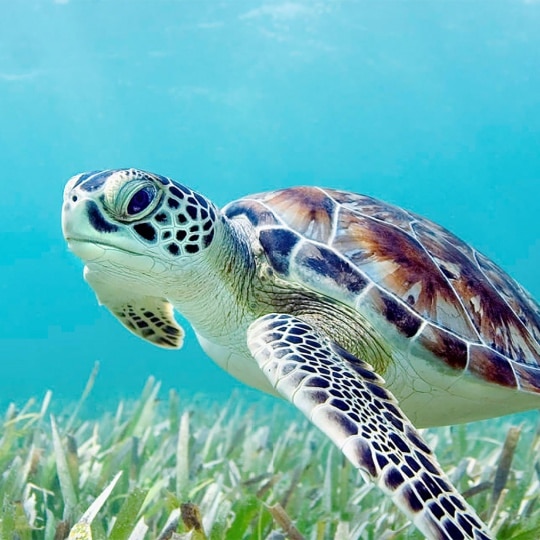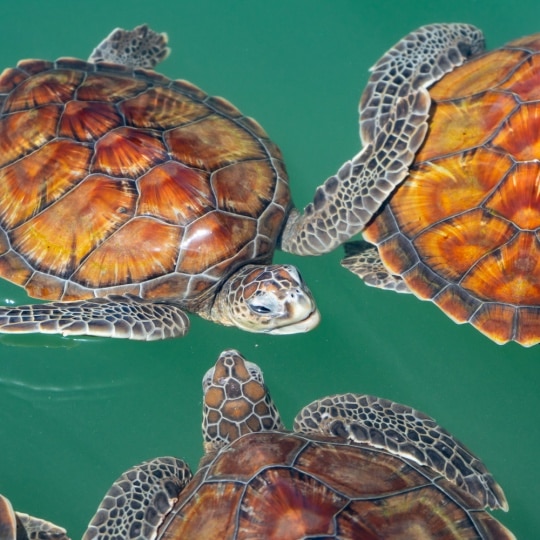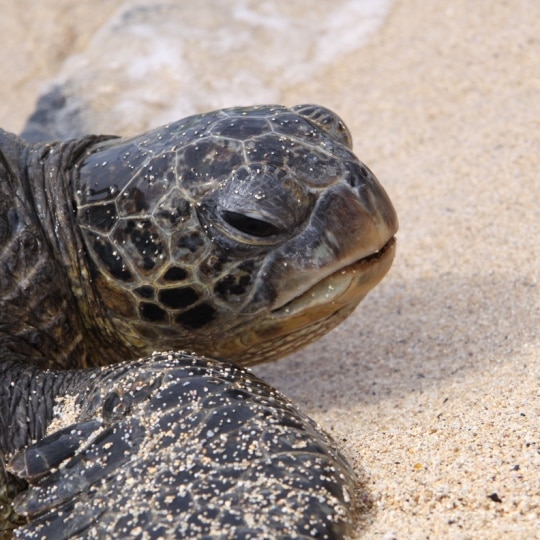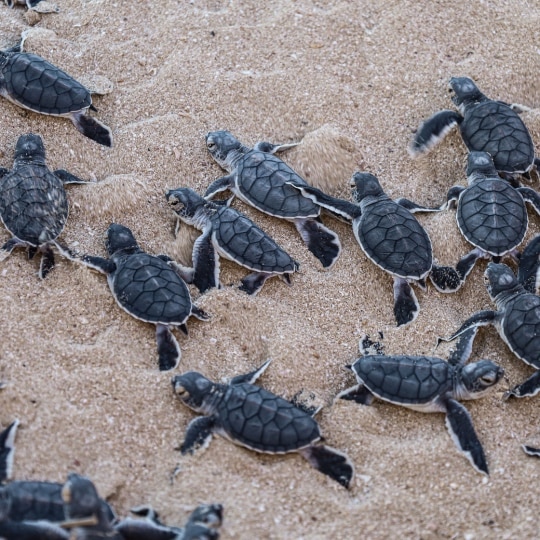Sea turtles are one of the oldest marine animals. They have been around 110 million years, making them as old as dinosaurs. But unlike their “cousins,” sea turtles survived, making them resilient, important members of the marine ecosystem.
Embark on an educational journey with us to learn more about sea turtles and how we can protect them.
Female sea turtles will navigate thousands of miles to return to the beach where they were hatched to lay their own eggs. This process, called natal homing, stems from their sensitivity to the Earth's geomagnetic fields.
A welcome note from Sage Butt
Where do sea turtles live?
Sea turtles are found in nearly all parts of the world, except in polar seas. Adult sea turtles live in shallow coastal waters, bays and lagoons. The males stay in the sea for the entirety of their lives, but the females go ashore to lay their eggs every two or three years.
What do sea turtles eat?
Sea turtles eat meat (carnivorous), plants (herbivorous), or both (omnivorous). They have varying diets based on their species and jaw structure.
For instance, the hawksbill’s preferred diet is sponges. Since they have serrated jaws, green sea turtles mostly eat sea grasses and algae.
Flatbacks have lower jaws with slightly serrated edges, allowing them to eat mollusks, sea cucumbers, sea pens, jellyfish and other marine invertebrates. Leatherbacks have relatively weak jaws compared to other sea turtles, which are unsuitable for chewing. This is why their diet is mainly made up of jellyfish and other soft marine animals.
Other types of sea turtles, such as the loggerheads, Kemp's Ridleys and Olive Ridleys, have jaws that can crush and grind food. Because of this, they eat mostly crabs, shrimp, other shellfish, jellyfish and aquatic plants.
Some species change their diet and eating habits as they mature. Green sea turtles eat mostly meat until they reach their juvenile stage. They then start eating more plants as they progress to adulthood.


How long do sea turtles live?
In the wild, sea turtles have a long lifespan – usually between 50 and 100 years. However, once they reach maturity, their estimated reproductive life is 30 years.




Why do sea turtles migrate?
Sea turtles migrate thousands of miles annually. They start their migration after hatching and emerging from their nests. Juvenile and adult sea turtles migrate seasonally to seek more suitable thermal habitats and food sources.
Their migration habits vary based on their species and populations. For instance, some groups of Olive Ridleys travel between the feeding and nesting grounds in the Eastern Pacific and Indian Oceans. Flatback sea turtles migrate from their nesting grounds in north Australia to northeastern Australia where there are abundant feeding grounds.
Scientific facts about sea turtles
Sea turtles have the following scientific classification:
Class: Reptilia
Order: Testudines
Families: Chelonioidea and Dermochelyidae
All sea turtles with scutes (shell patterns) or plates covering their shells belong to the Family Cheloniidae. The leatherbacks, which are scute-less and only have leathery skin, are the only members of the Family Dermochelyidae.
Characteristics and behaviors of sea turtles
Below are some noteworthy physical features and behaviors of sea turtles:
Size
The leatherbacks are the largest sea turtles, with carapaces (hard upper shells) reaching 1.2 to 1.8 meters. They weigh between 200 and 900 kilograms.
The Olive Ridleys are the smallest species. Their carapaces have an average length of 51 to 75 centimeters and they usually weigh between 33 and 50 kilograms.
Shell
Sea turtles have large shells with different shapes, ranging from oval to round and heart-shaped, which protect them from predators and injuries. Except for the leatherback, this shell is made of fused bones.
Both males and females from the same species have the same size.
Color
Sea turtles are different colors based on their species. For instance, leatherbacks have black carapaces (top of shell) with white spots and white plastrons (bottom of the shell) with dark marks. Hawksbills have shells with the combined colors of amber, brown, black, orange, red and yellow.
Flippers
Sea turtles use their flippers or limbs mainly for swimming. They cannot retract their flippers under their shells.
Behavior
Sea turtles are not social animals. Once they hatch and make their way to the ocean from their nest, they live a solitary life until they mate. However, some species gather together when they are offshore.
Special adaptations
Sea turtles developed these distinct qualities to help them adapt to and survive the constantly changing marine environment:
Swimming
The forelimbs of sea turtles have evolved into long, paddle-like flippers making them fast, strong swimmers. There are records of leatherbacks swimming at speeds of 1.5 to 9.3 kph.
Breathing
Can sea turtles breathe underwater? Since sea turtles are reptiles, they cannot breathe underwater; they need to breathe air.
However, depending on the species, they can hold their breath from 45 minutes to a maximum of five hours.
The black sea turtle can in fact go into a state of hibernation during the cold months of the year.
Sea turtles can exchange 27% to 80% of air in their lungs, which is significantly higher than those of land reptiles. This ability allows them to exchange all gasses within their lungs by taking just a few breaths.
Submersion and diving
Sea turtles are cold-blooded and have a slow metabolic rate, enabling them to remain underwater for long periods of time and allowing them to conserve energy and avoid predators. In particular, green sea turtles can stay submerged for up to five hours. These sea animals are also incredible divers, with leatherbacks diving up to 1,190 meters (3,900 feet).
Top facts about sea turtles
Here are some more interesting facts about sea turtles:
- Animal specialists can identify the species of a sea turtle by the number and pattern of scutes on their shells. For instance, Hawksbill sea turtles have five central scutes and four lateral scutes while Olive Ridleys have five central scutes and six or more lateral scutes.
- Countershading (a type of camouflage where the top part of the animal has a darker color while its underside is lighter) helps protect sea turtles from predators. Their dark back blends with the water when viewed from above while their lighter ventral side makes them harder to detect when seen from below.
- Some of the sea turtles’ adaptations make them slow, clumsy and vulnerable whenever they are on land. For instance, their limbs are adapted for swimming and not walking on sand, making it difficult for them to crawl fast. Also, they cannot retract their limbs under their shells, which means they cannot hide quickly from predators. The heavy body and flippers of female sea turtles means their journey to lay their eggs on land is a slow process.


Are sea turtles endangered?
The International Union for Conservation of Nature and Natural Resources considers the hawksbill and Kemp's Ridley as critically endangered. The IUCN categorizes the green turtle as endangered and the loggerhead, leatherback and Olive Ridley as vulnerable. There is insufficient data regarding the status of flatbacks.
But why are some sea turtles endangered? They hold this status due to the following threats:
- Human activities, including poaching and fisheries bycatch
- Pollution
- Coastal development, which affects the sea turtles’ nesting habitats
- Deforestation
- Climate change
- Predators such as tiger sharks and killer whales prey on sea turtles in the ocean. On land, ghost crabs, raccoons, dogs and seagulls can be seen raiding sea turtle nests or catching them as they make their first journey to sea.
Protecting sea turtles
Global conservation initiatives for sea turtle conservation include protecting nesting areas, regulating fishing gear and mitigating bycatch. Various projects have also been implemented to track and rehabilitate injured turtles as well as to conduct additional research and conservation.
You can protect sea turtles through the following ways:
- Always dispose responsibly to keep beaches clean and safe.
- Avoid using artificial light to illuminate beaches during sea turtle nesting season to protect their natural habitat.
- Avoid buying items made of sea turtle shells to combat illegal wildlife trade.
- Knock down your sandcastles before you leave the beach since sandcastles are like mountains for little sea turtle hatchlings when they are trying to make their first trip to the ocean from their nest!
Be amazed by these marine animals at SeaWorld Yas Island, Abu Dhabi
Watch sea turtles glide in a dynamic habitat at the Abu Dhabi Ocean at SeaWorld Yas Island, Abu Dhabi. You’ll be impressed by their beautiful shells and be in awe as they swim and dive elegantly.
Did you like this story?
If yes, sign up for our newsletter and be among the first to know when we release a new story.



